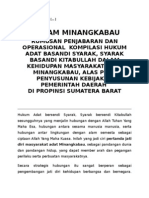Makalah Sejarah Islam Di Minangkabau

MAKALAH SENI TRADISIONAL MINANGKABAU. Latar Belakang. Kesenian anak ngari di minangkabau sangat beragam. Masyarakat Minangkabau yang mayoritas menganut.
Urang Minang Total population c. 8 million Regions with significant populations 6,462,713 934,000 15,720 7,490 Languages, (including both and standards) Religion Related ethnic groups,,,, Minangkabau people (: Urang Minang), also known as Minang, are an ethnic group indigenous to the of,. The Minangkabau's West Sumatran homelands was the seat of the, believed by early orientalists to have been the cradle of the, and the location of the (1821 to 1837).
Minangkabau are ethnic majority in. Minangkabau are also recognised minority in other parts of and,.
A statue believed to be, founder of a Minangkabau kingdom. The term Minangkabau (: Minang: مينڠ) came from a popular legend that was derived from a territorial dispute between a people and a prince from a neighbouring region. To avoid a battle, the local people proposed a fight to the death between two ( kabau) to settle the dispute. The prince agreed and produced the largest, meanest, most aggressive buffalo. The villagers on other hand produced a hungry baby calf with its small horns ground to be as sharp as knives. Seeing the adult buffalo across the field, the calf ran forward, hoping for milk.
The big buffalo saw no threat in the baby buffalo and paid no attention to it, looking around for a worthy opponent. Actia multi diag download. But when the baby thrust his head under the big bull's belly, looking for an udder, the sharpened horns punctured and killed the bull giving the villagers their victory ( manang, hence manang kabau: 'victors of the buffalo' which eventually became Minangkabau).
The legend however has its rebuttals as the word 'minang' refers to the consumption of ( pinang), yet there hasn't been any popular explanation on the word 'minang' that relates the aforementioned action to the word for 'water buffalo'. The first mention of the name Minangkabau as Minanga Tamwan, is in the late 7th century, describing sacred journey from Minanga Tamwan accompanied with 20.000 soldiers heading to Matajap and conquering several areas in the southern of Sumatra. Flag or marawa of Minangkabau. The is a member of the family, and is closest to the, though when the two languages split from a common ancestor and the precise historical relationship between Malay and Minangkabau culture is not known. Until the 20th century the majority of the Sumatran population lived in the highlands. The highlands are well suited for human habitation, with plentiful fresh water, fertile soil, a cool climate, and valuable commodities. It is probable that evolved in the long before it appeared in other parts of Sumatra, and predates significant foreign contact., a follower of with ties to the and kingdoms of Java, is believed to have founded a kingdom in the Minangkabau highlands at and ruled between 1347 and 1375.: 232 The establishment of a royal system seems to have involved conflict and violence, eventually leading to a division of villages into one of two systems of tradition, Bodi Caniago and Koto Piliang, the latter having overt allegiances to royalty.
 By the 16th century, the time of the next report after the reign of Adityawarman, royal power had been split into three recognised reigning kings. They were the King of the World ( Raja Alam), the King of Adat ( Raja Adat), and the King of Religion ( Raja Ibadat), and collectively they were known as the Kings of the Three Seats ( Rajo Tigo Selo).
By the 16th century, the time of the next report after the reign of Adityawarman, royal power had been split into three recognised reigning kings. They were the King of the World ( Raja Alam), the King of Adat ( Raja Adat), and the King of Religion ( Raja Ibadat), and collectively they were known as the Kings of the Three Seats ( Rajo Tigo Selo).